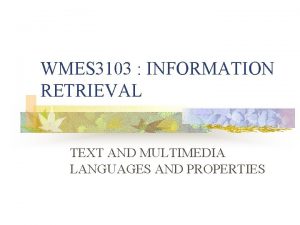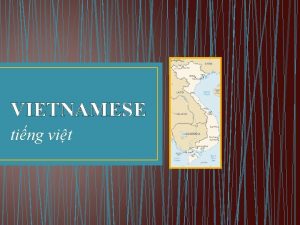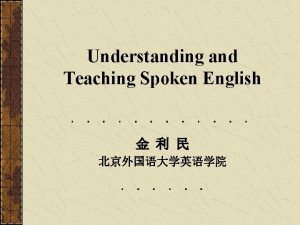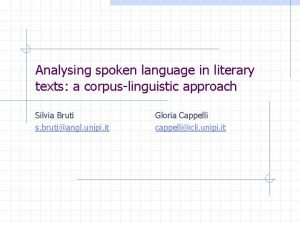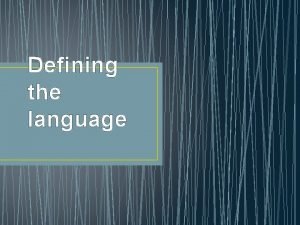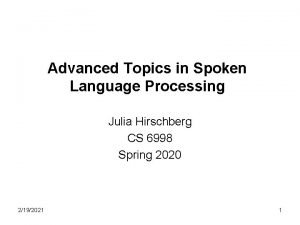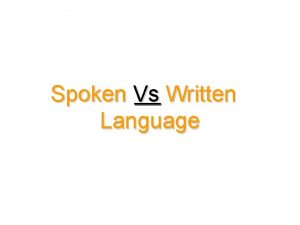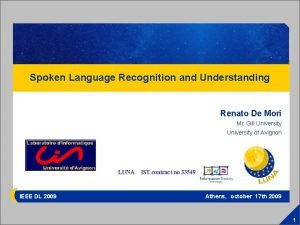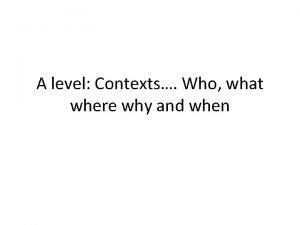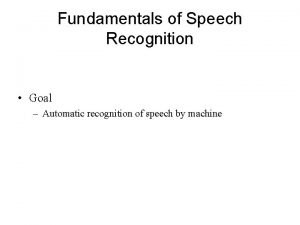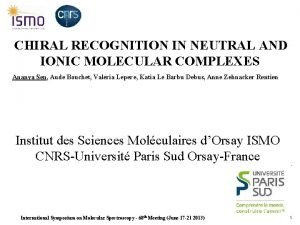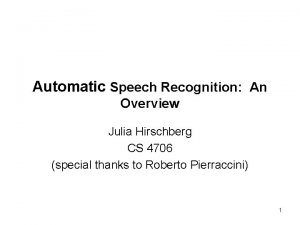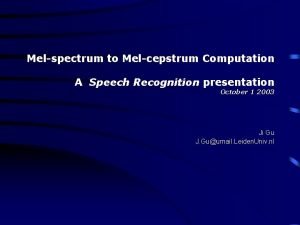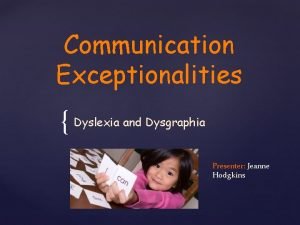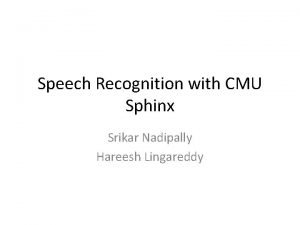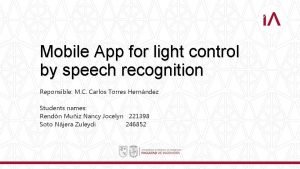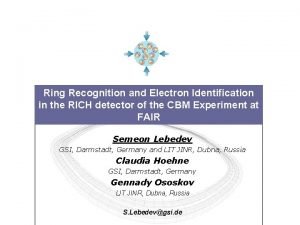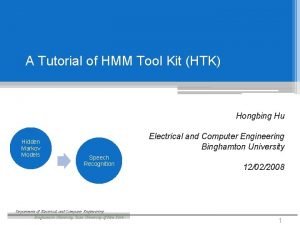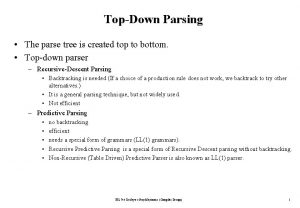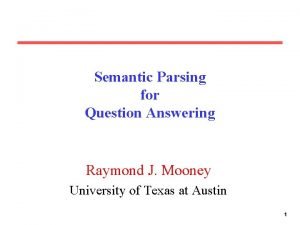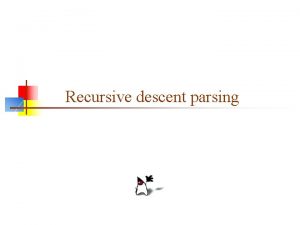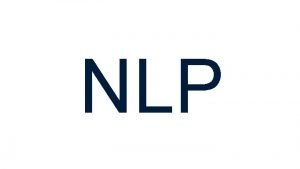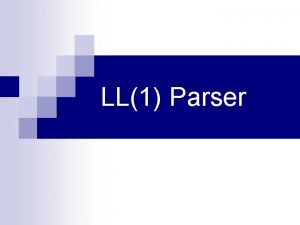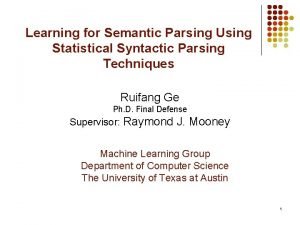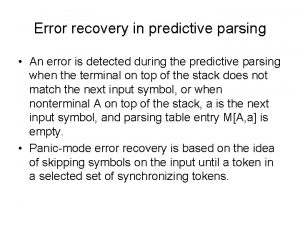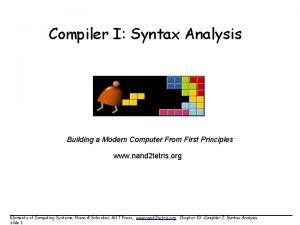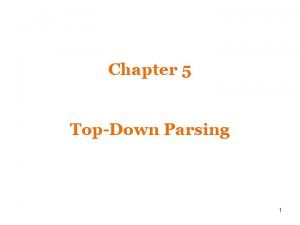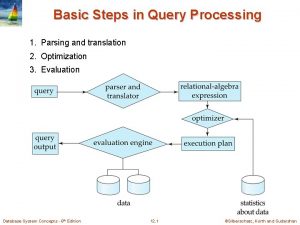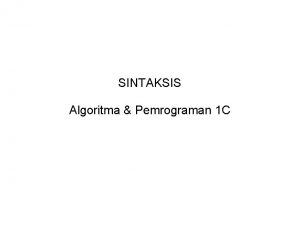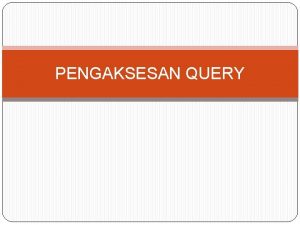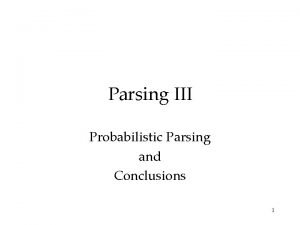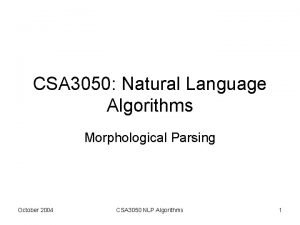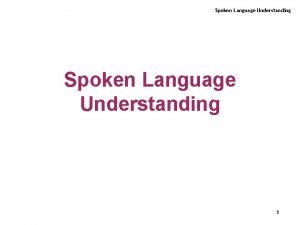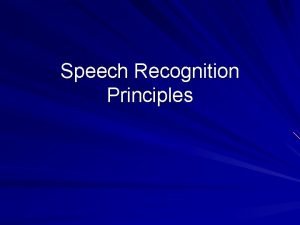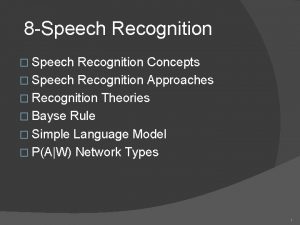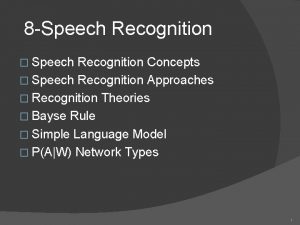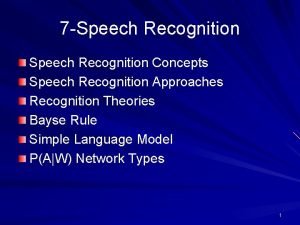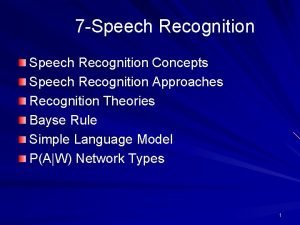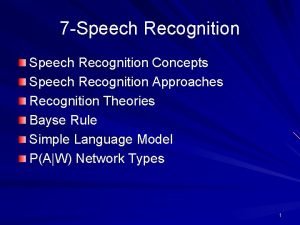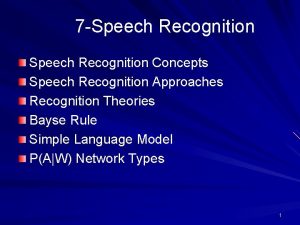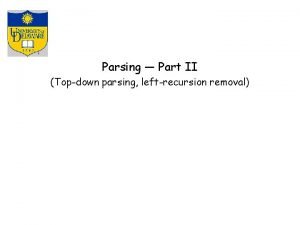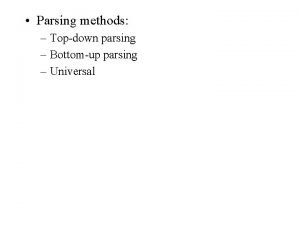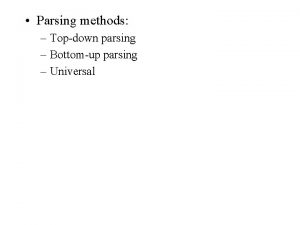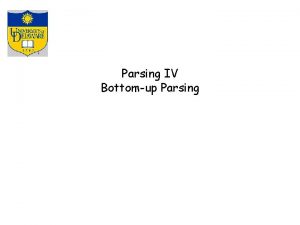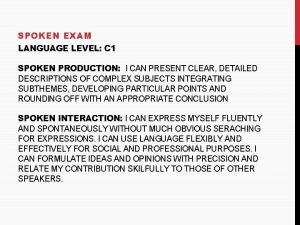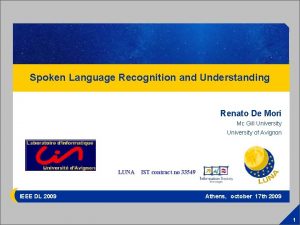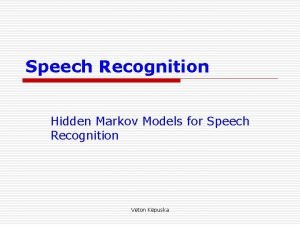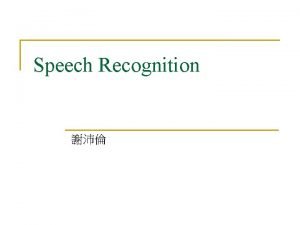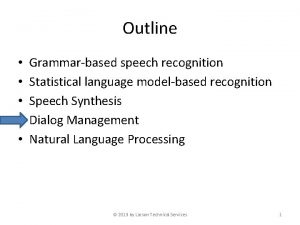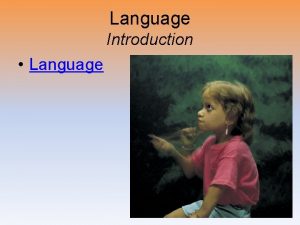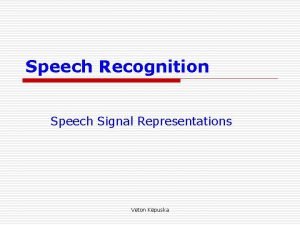Spoken Language Understanding Speech Understanding parsing recognition Speech








































- Slides: 40


Spoken Language Understanding § 음성언어 이해 고립단어인식 ← 음성인식(신호처리기반) + 자연어처리 핵심어 검출 연결단어 인식 낭독체 연속음성인식 Speech Understanding parsing recognition Speech Text synthesis 대화체 연속음성인식 Interpretation generation TTS Speech Generation TTS: Text-to-Speech CTS: Concept-to-Speech 음성언어처리 소개 2

Spoken Language Understanding System 음성언어처리 소개 3

W 3 C Speech Interface Framework for Voice Web Applications N-gram Grammar ML Speech Recognition Grammar ML Language ASR Lexicon Natural Language Semantics ML Understanding Voice. XML 2. 0 Context World Interpretation Wide DTMF Tone Recognizer Web Dialog Prerecorded Audio Player User Media Planning TTS Language Manager Telephone System Generation Reusable Components Speech Synthesis ML 음성언어처리 소개 4

Continuous Speech Recognition 연속 음성 인식 시스템 구성도 Search Speech input Signal processing front-end Word-level matching Front-end converts the raw acoustic waveform into A. Acoustic model gives an estimate of P(A|W). Sentence-level matching Recognized sentence Search network generation Language model gives an estimate of P(W). Decoder finds Ŵ among all W. Acoustic Model Lexicon Language Model 음성언어처리 소개 Language Model (Phone-level) Acoustic Model Language Model Word Model (Lexicon) 5

Standard Model for Continuous Speech Recognition W Recognition Training L 10 ms A 음성언어처리 소개 6

Decoder (Search Network) Feature Extractor 가격은 얼마 … N-gram K AA FSN G . . . (Phone-level) Acoustic Model Word Model (Pronunciation Lexicon) 음성언어처리 소개 Language Model (Grammar) 7

Language Model Theory § Perplexity § Role of Language Models § Linguistics-based Grammars § Finite-State Grammars § Statistical Language Models § § N-grams Class-based N-grams Probabilistic Context-Free Grammars Smoothing § Data Sparseness Problem § Linear Interpolation § Discounting § Backing-off 언어모델 소개 8

Perplexity § Branching factor § the number of items in the active vocabulary at a single point in the application § Perplexity: average branching factor § the amount of branching found in an entire application § an application consisting entirely of “yes” and “no”: perplexity = 2 § measure of language model quality based on the concepts of entropy § D: new data sample § M: given language model 언어모델 소개 9

Role of Language Models § Speech recognition applications do not consist of an unorganized conglomeration of words. They possess the same structure and sequence as the tasks to which they are linked. That structure can be as rigid as a command sequence for controlling a piece of equipment or as flexible as dictation. The methods used to organize application vocabularies are called language models. § Language model reduces perplexity. § Recognition step involves searching through the application vocabulary (active vocabulary) to locate the best match for spoken input. § Reduce perplexity by limiting the words in the active vocabulary or assigning a probability ranking to those items. § Language model increases speed and accuracy. § Fewer candidates for a recognizer to evaluate § Language model enhances vocabulary flexibility. § Place confusable words in different active vocabulary set, i. e. , words within each active vocabulary are acoustically distinct. 언어모델 소개 10

Linguistics-based Grammars § Focus is on designing a system that understands the sense of what user has said as well as identifying the spoken word. § Why linguistics-based models? § Use of additional knowledge will refine the active vocabulary by eliminating illogical or impossible choices. § Cognitive, behavioral and linguistic knowledge are natural components of human interaction. § Natural, flexible, user-friendly, human-like speech recognition is a byproduct of including non-acoustic knowledge about human communication. 언어모델 소개 11

Linguistics-based Grammars § Context-free grammar § Define allowable structures (deterministic) with context-free rules. § Chart parsing applies the context-free rules to the spoken input and keeps track of the rules that were successful by placing them on a chart. KEY : S → NP VP NP → DET NP NP → ADJ N VP → AUX VP VP → V PP PP → PREP NP S = sentence NP = noun phrase VP = verb phrase PP = prepositional phrase V = verb ADJ = adjective N = noun AUX = auxiliary verb DET = determiner PREP = preposition 언어모델 소개 12

Linguistics-based Grammars § Grammars with multiple knowledge sources § morphology, syntax, semantics, pragmatics, discourse, common-sense knowledge § Combine syntactic analysis with semantics, statistics and other sources of knowledge. § Include analysis of the conversational interaction with the user (discourse processing). § Pragmatic constraints are knowledge sources used to predict the content of the user’s next utterance. 언어모델 소개 13

Finite State Grammars § Reduce perplexity by describing the words that are allowable at any point in the input. § Simplify application development by replacing listings of allowable utterances with generic descriptions. § SENTENCE 1 = Input utterance: Part-number NUMBER Part-number 1 2 3 Part-number 9 8 4 5 $digit = 0|1|2|…|9; $number = $digit {$digit}; 언어모델 소개 14

Finite State Grammars Syntax of SSI’s Phonetic Engine 언어모델 소개 15

Finite State Grammars § Problems § Only the word and sentence sequences that have been programmed into grammar can be recognized (not flexible). § cannot rank active vocabulary in terms of their likelihood of occurrence (i. e. all members of the active vocabulary have the same likelihood of occurrence). § represented using finite-state networks like HMM but neither the states nor the transitions are characterized by probability. § Finite-state grammars in commercial recognition systems § Most effective in structured applications such as data entry and voice-andcontrol of equipment. § Difficult things are identifying and defining the linguistic and structural requirements of the task. § Need to insure that the people using the system speak only the allowable words and word sequences. § These techniques are less useful for applications that expect large populations of one-time users. 언어모델 소개 16

Statistical Language Models Acoustic Model Word history Language Model N-grams Class-based N-grams Probabilistic context-free grammars 음성언어처리 언어모델 소개 소개 17

N-grams § Word histories according to the last N-1 words § The choice of N is based on a trade-off between detail and reliability, and will be dependent on the quantity of training data available. § Bigram (N = 2) § fewer parameters → more reliably estimated § Trigram (N = 3) § more precise → more accurate language model § need sufficient training data § For the quantities of language model training data typically available at present, trigram models strike the best balance between precision and robustness, although interest is growing in moving to 40 gram models and beyond. 언어모델 소개 18

N-grams § Advantages § simplicity § easy and efficient to train, even when corpora of millions of words are used § can be based on a large amount of real data § simultaneously encode syntax and semantics § can be easily included in the decoder of a speech recognizer § Disadvantages § cannot handle long-range dependencies § The current word is clearly dependent on much more than the previous one or two words. § recognition error due to nonsensical or ungrammatical word combinations § a brilliant financial analysts § N-gram approach can fragment the data unnecessarily. 언어모델 소개 19

Class-based N-grams § Define a mapping of the vocabulary words into a smaller number of classes. The N-grams are then based on these classes. § Classes § linguistically motivated: part-of-speech or linguistic function § groups of similar fashion: days of the week, numbers, airline names § automatically derived from the training data the most commonly used form 언어모델 소개 20

Class-based N-grams § Advantages § § much more compact than word-based models use more context reduce the problem of data sparsity make much more reliable probability estimates for event unseen in the training data § Class-based models have been particularly successful in situations where limited quantities of training data were available. § Disadvantages § lose some of the semantic information § This problem can be partially overcome by constructing language models which combine information from word-based and class-based models § still fails to overcome the problems of long-term dependencies 언어모델 소개 21

Probabilistic Context-Free Grammars § CFG consists of § terminal symbols : words § non-terminal symbols : grammatical objects § rewrite rules : specify how symbols can be related § A PCFG assigns probabilities to each of the rewrite rules. § Each parse of a sentence has a probability associated with it. § The sum of these can be considered to be the probability of the sentence. § Train PCFGs by estimating appropriate rewrite rule probabilities. § Select probabilities which maximize the likelihood of training corpus. 언어모델 소개 22

Probabilistic Context-Free Grammars § Advantages § linguistically motivated § capture the long-range dependencies that are ignored by N-gram models § PCFGs have been used successively in some smaller vocabulary tasks. § Disadvantages § syntactic approach → lose much of the useful semantic information that word-based N-gram models encode § The training algorithms are very computationally demanding, and have not seen much use except on very small training corpora. 언어모델 소개 23

Data Sparseness Problem and Smoothing § Data sparseness problem § The maximum likelihood estimate for the probability is biased high for observed events and biased low for unobserved ones. § In an N-gram language model it is impossible to avoid the problem of unseen events. § 64, 000 word vocabulary → 2. 62 × 1014 possible trigrams → Even a 100 million word training corpus can contain at most 0. 000038% of these trigrams. § If a trigram never occurs in the training text, then the method of maximum likelihood estimation will assign any string which contains the trigram a probability of zero, and it will not be correctly transcribed by the speech recognition system. § The perplexity of the model with respect to any text which contains this string will be infinite. § Need techniques § to smooth the data to correct the bias of the maximum likelihood estimates. § to ensure that no word strings are assigned zero probabilities. 언어모델 소개 24

Linear Interpolation § In order to avoid zero probabilities, define the N-gram probabilities to be a linear combination of the 1 -gram, 2 -gram, …, N-gram maximum likelihood probability estimates. Trigram probability: R = # of words in the training text 1+ 2+ 3 = 1 언어모델 소개 25

Discounting § Discounting is a more principled method of correcting the bias towards observed events of maximum likelihood probability estimates. § An event’s count is discounted by multiplying it by a discount coefficient. § The remaining probability mass is distributed among unseen events. 언어모델 소개 26

Good-Turing Discounting § the most commonly used discounting scheme § first applied by Katz who used it in conjunction with backing-off § Diadvantages § It is necessary that dr>0 for all r, and this puts some constraints on the relative values of n 1, n 2, …, nk+1. § These constraints will be satisfied by naturally occurring data but may not be if one has doctored the data in some way (for example by boosting the counts of some subset of the N-grams). 언어모델 소개 27

Witten-Bell Discounting § The discounting coefficient is dependent not on the event’s count, but on t. § t: the number of distinct events which followed the particular context § For the bigram “A B”, t is the number of distinct bigrams of the form “A *”, which occurred in the training data. § Motivation § Assign probability estimates to unseen events which reflect how many times novel events have been seen in the past. § T is viewed as being the number of times that a novel event has previously been observed following a particular context. 언어모델 소개 28

Absolute Discounting § Subtract a constant b from each of the counts. Linear Discounting § Subtract a quantity proportional to each count from the count itself. 언어모델 소개 29

Backing-off § If data in a language model is insufficient to accurately estimate a word probability, back-off to a less specific language model. § N-gram (N-1)-gram § word-based trigram class-based trigram back-off weight 언어모델 소개 30

한국어 연속음성인식 시스템 Search Speech input Signal processing front-end Recognizer Training Speech database Word-level matching Sentence-level matching Acoustic Model Lexicon Language Model HMM 기반 Subword Model Grapheme-to. Phoneme Vocabulary N-grammar 대용량 학습용 발음열 형태소기반 발음사전 연속음성 DB Phonetic Transcription Pronunciation Dictionary Recognized sentence 사전의 표제어 및 디코딩 단위 한국어 발음열 자동 생성 시스템 Automatic Transcription generation of pronunciation variants Text Corpus 형태소 분석 (음가 기준) 형태소 한국어 연속음성인식을 위한 언어모델 31









 Kinect for windows speech recognition language pack
Kinect for windows speech recognition language pack Spoken language audio retrieval in irs
Spoken language audio retrieval in irs Language vietnamese
Language vietnamese Spoken language features
Spoken language features Turn constructional component
Turn constructional component Most spoken language in the world
Most spoken language in the world Branches of linguistics
Branches of linguistics Most spoken language in the world
Most spoken language in the world Adv spoken language processing
Adv spoken language processing Language
Language Renato de mori
Renato de mori Why was french the language spoken in valmonde
Why was french the language spoken in valmonde Fundamentals of speech recognition
Fundamentals of speech recognition Deep learning speech recognition
Deep learning speech recognition Aude leperre
Aude leperre Julia speech recognition
Julia speech recognition Melspectrum
Melspectrum How a dyslexic person sees text
How a dyslexic person sees text Cmu speech recognition
Cmu speech recognition Speech recognition
Speech recognition Speech recognition app inventor
Speech recognition app inventor Dragon speech recognition
Dragon speech recognition Electron speech to text
Electron speech to text Htk speech recognition tutorial
Htk speech recognition tutorial Another tool for language recognition
Another tool for language recognition Top-down parser
Top-down parser Semantic parsing
Semantic parsing Recursive descent parsing
Recursive descent parsing Parsing methods
Parsing methods Ll(1) parser program in java
Ll(1) parser program in java Parsing syntax
Parsing syntax Error recovery in predictive parsing
Error recovery in predictive parsing The lexical analysis for a modern computer
The lexical analysis for a modern computer Recursive descent parsing
Recursive descent parsing Parsing and translation in query processing
Parsing and translation in query processing Move the bottom up and down
Move the bottom up and down Yang memeriksa sintaks dan memeriksa relasi adalah
Yang memeriksa sintaks dan memeriksa relasi adalah Parsing adalah
Parsing adalah Probabilistic parsing
Probabilistic parsing Yichao zhou
Yichao zhou Morphological parsing in nlp
Morphological parsing in nlp

